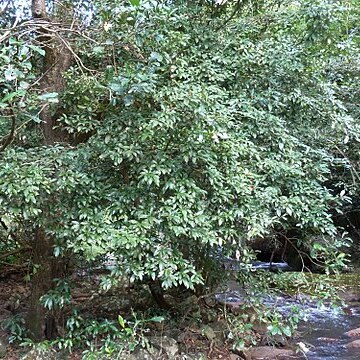A medium-sized tree, 6-17 m high, but often fruiting freely without much height; stem up to 50 cm in diam., bark smooth; twigs slender, terete, grey, glabrescent; inter-nodes decreasing in length towards the apex, so that the leaves are crowded at the tops of the twigs; innovations and calyx densely dark tobacco-brown-tomentose. Leaves obovate-lanceolate, (ob)lanceolate-elliptic or(ob)lanceolate-oblong, 6-15 cm long and 2-5 cm broad, shortly acuminate, acute or obtuse, gradually tapering into the acute or somewhat acuminate base; when mature, green (drying a characteristic greyish-green), glabrous and very shiny above, very minutely greyish-or silvery-tomentose, later sometimes glabrescent beneath, with entire, subdeflexed and more or less undulate margins; midrib immersed and channelled above, prominent and conspicuous below; secondary nerves thin, raised, about 20 on either side, patent, almost straight, bifurcate usually well within the margin and archingly joining, no distant intramarginal vein present; tertiary nerves inconspicuous, mostly parallel to secondary ones; petioles often brown or blackish, rugose 6-14 mm long; stipules 0. Flowers sessile, in clusters of 1-3(rarely more) in the leaf axils; bracts small, inconspicuous or wanting. Calyx about 4 mm long, divided more than half way down, the segments erect, ovate, subacute. Corolla 'white' or 'yellowish', glabrous; tube somewhat longer than the calyx, more or less constricted above the middle; lobes suberect, ovate, obtuse, about 1 mm long. Anthers subsessile, inserted at the very base of and about as long as the corolla-lobes, ovate, apiculate. Ovary depressed-globose, more or less 5-lobed, shortly pilose, contracted into the glabrous, obtuse, cylindrical style which is up to about twice as long as the ovary. Berry subsessile, cylindric-ovoid or cylindric-oblong, pointed (more or less shaped like an acorn), crowned with the persistent style, 2-2.5 cm long and 1-1.5 cm in diam., deep red when ripe (? also sometimes transparent white, Sim) minutely pubescent, one-seeded, edible. Seed ellipsoid-oblong, about 20 mm long, 8 mm wide, and 5 mm thick in the centre, with an oblong 2.5 mm wide scar occupying the whole ventral side of the seed; testa thin, brittle.
More
Perennial shrub, 1-15 m high, bark brown, branchlets densely brown. Leaves many at branch ends, oblanceolate to narrowly elliptic, greenish drying greyish green, puberulent, base narrowly acute, apex acuminate, lateral nerves inconspicuous. Flowers solitary, in fascicles, sessile. Calyx a single whorl of 5(6), slightly ovate lobes, thick and leathery. Corolla shortly tubular; lobes 5(-10), white-yellowish. Stamens 5(-10); anthers extrorse; filaments well developed, sometimes converted to petaloid scales in female flowers. Flowering time July-Jan. Fruit a 1-seeded berry, 25 x 15 mm, deep red. Seeds ellipsoid, testa thin, brittle, ventral scar ± 2.5 mm wide.
Medium-sized tree, 6-17 m high. Leaves usually bluntly acuminate at apex, usually silvery white on lower surface. Flowers sessile, solitary or 2 or 3 together in leaf axils; white or yellowish.


